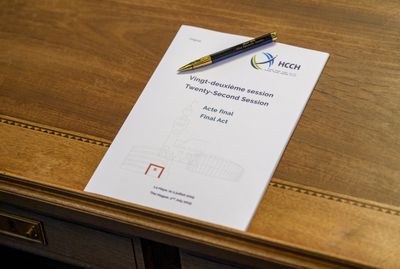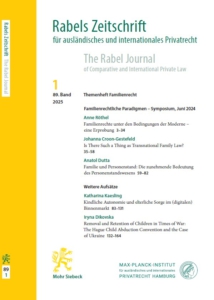Views
Judgments Convention – No Thanks?
On September 1st, 2023, the 2019 Hague Judgments Convention will enter into force for the Member States of the EU and Ukraine. According to the HCCH, the Convention is “a true gamechanger in international dispute resolution”, which will “reduce transactional and litigation costs, facilitate rule-based multilateral trade and investment, increase certainty and predictability” and “promote effective justice for all”. The international conference taking place in Bonn later this week will likely strike an equally celebratory tone.
This sentiment is not shared universally, though. In a scathing article just published in Zeitschrift für Europäisches Privatrecht (ZEuP) entitled ‘Judgments Convention: No Thanks!‘, Haimo Schack (University of Kiel) labels the Convention as “evidently worthless”.

Schack comes to this damning conclusion in three steps. First, he argues that the 2005 Choice of Court Convention, the first outcome of the decades-long HCCH Jurisdiction Project, has been of minimal use for the EU and only benefited Singapore and London. Read more
Towards an EU Regulation on the International Protection of Adults
On 31 May 2023, the European Commission presented a proposal for a Regulation on jurisdiction, applicable law, recognition and enforcement of measures and cooperation in matters relating to the protection of adults (in the following: EU Adult Protection Regulation – EUAPR). This proposal is a response to significant demographic and social changes in the EU: Many Member States face enormous challenges posed by an increasingly aging population. Due to considerable improvements in medical care in recent decades, people grow much older than they used to, and this lengthening of the average lifespan in turn leads to an increase in age-related illnesses such as Alzheimer’s disease. This demographic change creates problems for private international law, because the mobility of natural persons has increased within the EU where borders may, in principle, be crossed without restrictions. Many people who have left their state of origin in search for work elsewhere in their youth or middle age do not return to their home state after retirement, but rather spend the last part of their lives where they have established a new habitual residence. Besides, more and more people decide to leave their home state once they have reached the age of retirement. Such processes of migration at a late stage in life may have different reasons: Some old-age movers may want to avoid a heavy taxation of their estates that would put a burden on their heirs, some may wish to circumvent other restrictions of domestic inheritance laws (e.g. the right to a compulsory portion), others may simply wish to spend the remaining parts of their lives in milder climates, e.g. the Mediterranean, or look for a place to stay where the cost of living is lower, e.g. in some parts of Eastern Europe. When these persons begin to suffer from an impairment or an insufficiency of their personal faculties which no longer allows them to protect their interests themselves, however, intricate conflict of laws problems may arise: The authorities or courts of which state shall have jurisdiction to take protective measures concerning vulnerable adults or their property? Which law is to be applied to such measures? Under which conditions may protective measures taken in one state be recognised and enforced in other states?
The EUAPR is meant to solve these problems. Read more
Dubai Courts on the Recognition of Foreign Judgments: “Recognition” or “Enforcement”? – that’s the Problem!
“Recognition” and “enforcement” are fundamental concepts when dealing with the international circulation of foreign judgments. Although they are often used interchangeably, it is generally agreed that these two notions have different purposes and, ultimately, different procedures (depending on whether the principle of de plano recognition is accepted or not. See Béligh Elbalti, “Spontaneous Harmonization and the Liberalization of the Recognition and Enforcement of Foreign Judgments, Japanese Yearbook of Private International Law, Vol. 16, 2014, p. 269).
However, in legal systems where this fundamental distinction is not well established, the amalgamation of the two notions may give rise to unnecessary complications that are likely to jeopardize the legitimate rights of the parties. The following case, very recently decided by the Dubai Supreme Court, is nothing but one of many examples which show how misconceptions and confusion regarding the notion of “recognition” would lead to unpredictable results (cf. e.g., Béligh Elbalti, “Perspective of Arab Countries”, in M. Weller et al. (eds.), The 2019 HCCH Judgments Convention – Cornerstones, Prospects, Outlook (Hart, 2023) pp. 1983-184ff).
News
Praxis des Internationalen Privat- und Verfahrensrechts (IPRax) 2/2025: Abstracts
The latest issue of the „Praxis des Internationalen Privat- und Verfahrensrechts“ (IPRax) features the following articles:
Out now: Festschrift für Thomas Rauscher
Prof. Dr. Dr. h.c. Thomas Rauscher, formerly a professor of private international law at the University of Leipzig (Germany) and still one of the most prolific commentators on German and European PIL, has been honoured by a Festschrift on the occasion of his 70th birthday. The volume, titled “Europeanization of private law”, has 623 pages and is published by CH Beck (Munich). It contains numerous contributions on private international law, comparative law and international civil procedure. The authors come from various countries, including Germany, Austria, Hungary, the United States and Vietnam. Most contributions are in German. For further information and a table of contents, please click here.
New issue alert: RabelsZ 89(2005)
 Issue 1/2025 of RabelsZ has just just been released. It contains the contributions to a family law symposium held at the Max Planck Institute in Hamburg in June 2024. All content is Open Access: CC BY 4.0 and more articles are available Online First.
Issue 1/2025 of RabelsZ has just just been released. It contains the contributions to a family law symposium held at the Max Planck Institute in Hamburg in June 2024. All content is Open Access: CC BY 4.0 and more articles are available Online First.
Anne Röthel, Preface to this family law special, pp. 1–2, https://doi.org/10.1628/rabelsz-2025-0003


